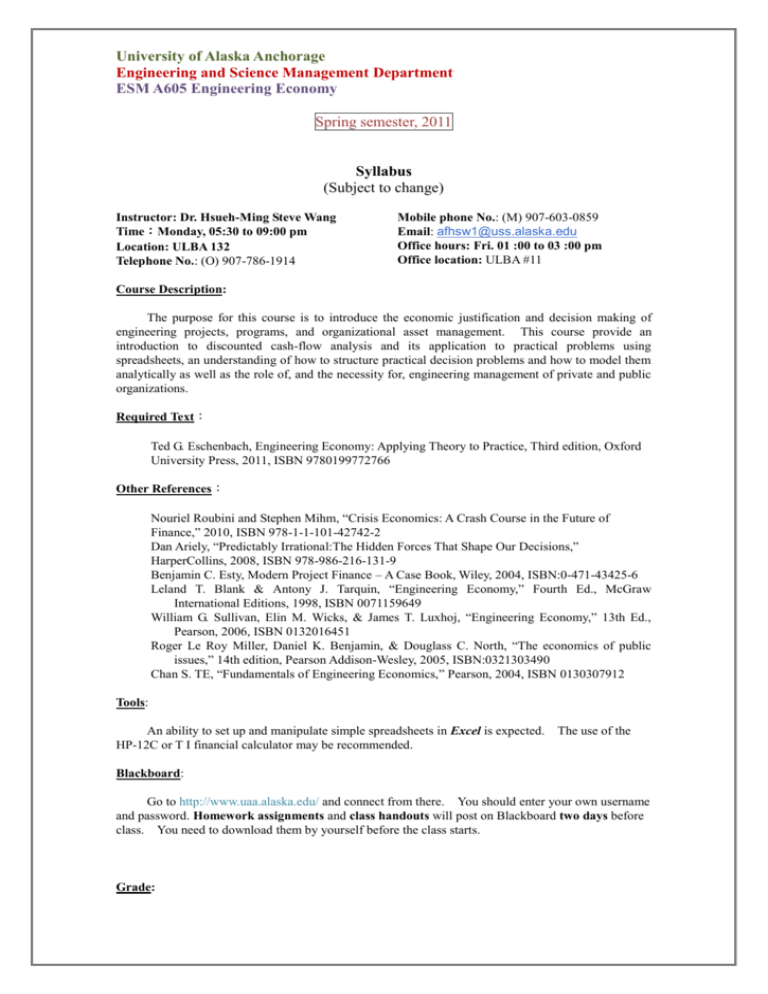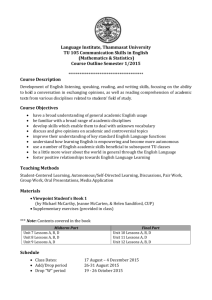
University of Alaska Anchorage
Engineering and Science Management Department
ESM A605 Engineering Economy
Spring semester, 2011
Syllabus
(Subject to change)
Instructor: Dr. Hsueh-Ming Steve Wang
Time:Monday, 05:30 to 09:00 pm
Location: ULBA 132
Telephone No.: (O) 907-786-1914
Mobile phone No.: (M) 907-603-0859
Email: afhsw1@uss.alaska.edu
Office hours: Fri. 01 :00 to 03 :00 pm
Office location: ULBA #11
Course Description:
The purpose for this course is to introduce the economic justification and decision making of
engineering projects, programs, and organizational asset management. This course provide an
introduction to discounted cash-flow analysis and its application to practical problems using
spreadsheets, an understanding of how to structure practical decision problems and how to model them
analytically as well as the role of, and the necessity for, engineering management of private and public
organizations.
Required Text:
Ted G. Eschenbach, Engineering Economy: Applying Theory to Practice, Third edition, Oxford
University Press, 2011, ISBN 9780199772766
Other References:
Nouriel Roubini and Stephen Mihm, “Crisis Economics: A Crash Course in the Future of
Finance,” 2010, ISBN 978-1-1-101-42742-2
Dan Ariely, “Predictably Irrational:The Hidden Forces That Shape Our Decisions,”
HarperCollins, 2008, ISBN 978-986-216-131-9
Benjamin C. Esty, Modern Project Finance – A Case Book, Wiley, 2004, ISBN:0-471-43425-6
Leland T. Blank & Antony J. Tarquin, “Engineering Economy,” Fourth Ed., McGraw
International Editions, 1998, ISBN 0071159649
William G. Sullivan, Elin M. Wicks, & James T. Luxhoj, “Engineering Economy,” 13th Ed.,
Pearson, 2006, ISBN 0132016451
Roger Le Roy Miller, Daniel K. Benjamin, & Douglass C. North, “The economics of public
issues,” 14th edition, Pearson Addison-Wesley, 2005, ISBN:0321303490
Chan S. TE, “Fundamentals of Engineering Economics,” Pearson, 2004, ISBN 0130307912
Tools:
An ability to set up and manipulate simple spreadsheets in Excel is expected.
HP-12C or T I financial calculator may be recommended.
The use of the
Blackboard:
Go to http://www.uaa.alaska.edu/ and connect from there. You should enter your own username
and password. Homework assignments and class handouts will post on Blackboard two days before
class. You need to download them by yourself before the class starts.
Grade:
Homework 25%
Final examination 25%
Project 30%
Midterm examination 20%
Participation 10%
The policy for the student final grade will be based on the relative distribution of the calculation of
students’ final results. Transformation of the final results may be applied to all final grades with
the same formula, when the raw data of the final grades distribute in a small range. The grades
for lower outliners in the distribution curve of the final grades will be “C.” The difference
between the grades for “A’ and “B” will be based on the distribution curve. If the curve is
bimodal, the higher grade group will be “A.” and the lower grade group will be “B.” If the
distribution curve is mono-modal, then 60% of the higher rank students may obtain “A.” The rest
of the students in the distribution may obtain “B.” The exceptional situation may be taken into
consideration based on the final performance evaluation of the students.
Assessment:
‧ Homework
Homework will be assigned about every week in the form of a problem set. For each
problem set, 50% of the points will be awarded for completeness (i.e., a serious attempt at all
problems), 50% will be allocated to accuracy in the selected problems. Homework is due at the
beginning of the class in Room ULBA 132 on its due date. Will be collected in class, graded, and
returned. Late homework receives ½ credit. The basis for grading is effort – full credit for most
incorrect answers.
‧ Exams
There will be a midterm exam in the 10th week in class. The final exam will be given after
the 15th week. Mid-term will be open book and notes in class exam. Final exam will be take
home exam. You are expected to take the midterm and final exam on the dates given. There are
no makeup exams! If you have a justified scheduling conflict (e.g., a varsity commitment), you
will have to make an arrangement with me two weeks before the exam. Any requests made after
that day (other than documented emergencies) may or may not be granted.
‧ Class Participation
Your presence and participation in class are essential for gaining mastery of the material. At
first sight it might seem to you that the concepts in this course are easy and might be quickly
“crammed” before an exam. Experience shows that this first impression is more often than not
incorrect, and in this course we therefore require your attendance and participation. From time to
time there may be a mini-quiz in class. The results will enter into your class participation grade.
Cellar phone is not allowed during the class. Please turn off your cellar phone before you enter
the classroom. We will do 360 degree evaluation in each class.
‧ Project
At least two students will be grouped as a project team. Two to three teams will be
organized in the first class. Each team needs to find out a subject for your team project related to
the course issues taught in the class and to develop a project by the team members together. A
five-page written project report with double space & font size 12 point is required to submit before
your final project presentation. I have attached a memorandum format on the blackboard for your
reference. There are two projects needed to be finished in this course. Each team needs to present
your projects in both the 8th and the 13th week of the semester. For each project, 60% of the points
will be awarded for completeness of project based on the project report, 20% will be allocated to
the team work, and 20% will be counted on the team presentation.
Your team needs to submit
Microsoft Power Point file as well as the final report through Blackboard before one week of the
project presentation. No late report will be accepted and there is no makeup report! The 360
degree evaluation from each team will be used as a reference to assign a grade for each team.
The final grades will be 95, 90, 85, 80, & 75.
Re-grading Policy.
Questions and concerns regarding grading (of problem sets, exams, and quizzes) must be
submitted in writing along with the entire assignment to me (if available. Any resubmission of the
assignment will result in the entire assignment being re-graded. This means that your score after
re-grading can be above or below your original score. Re-grading requests will only be accepted
within one week of the date of return of the graded item in question.
Schedule:
Reading
Week
Date
Content
Assignment
1
1/10
Course Overview; Engineering Economic Decisions; Time Value of Money TE, Ch.1&2
2
1/17
(No Class) Martin Luther King Jr. Day
3
1/24
Economic Equivalence
TE, Ch. 3
4
1/31
Spreadsheets and Economic Analysis
TE, Ch. 4
5
2/7
Present and Annual Worth
TE, Ch. 5-6
6
2/14
IRR and other measures of Economic Worth
TE, Ch. 7-8
7
2/21
Mutually Exclusive Alternatives
TE,Ch.9
8
2/28
Project I Presentation
9
3/7
Spring Break (No Class)
10
3/14
Midterm Examination
11
3/21
Constrained Project Selection & Sensitivity Analysis
TE,Ch.11&17
12
3/28
Replacement Analysis (Depreciation and Income Taxes)
TE,Ch.10,12-13
13
4/4
Public Sector and Inflation
TE,Ch.14-15
14
4/11
Final Examination
15
4/18
Project II Presentation
Student Code of Conduct
Abstract from:
www.uaa.alaska.edu/deanofstudents/StudentJudicialServices/.../Student-Code-of-Conduct.pdf
The examples provided in this section of actions constituting forms of conduct prohibited by the Code
are not intended to define prohibited conduct in exhaustive terms, but rather to set forth examples to
serve as guidelines for acceptable and unacceptable behavior. (R09.02.020)
1. Cheating, Plagiarism, or Other Forms of Academic Dishonesty:
[1] using material sources not authorized by the faculty member during an examination or
assignment;
[2] utilizing devices that are not authorized by the faculty member during an examination or
assignment;
[3] providing assistance to another student or receiving assistance from another student during an
examination or assignment in a manner not authorized by the faculty member;
[4] presenting as their own the ideas or works of another person without proper acknowledgment
of sources;
[5] knowingly permitting their works to be submitted by another person without the faculty
member's permission;
[6] acting as a substitute or utilizing a substitute in any examination or assignment;
[7] fabricating data in support of laboratory or field work;
[8] possessing, buying, selling, obtaining, or using a copy of any material intended to be used as
an instrument of examination or in an assignment in advance of its administration;
[9] altering grade records of their own or another student's work; or
[10] offering a monetary payment or other remuneration in exchange for a grade.






